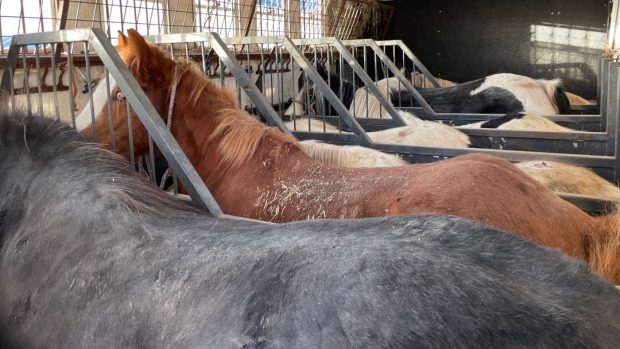THE equestrian industry has welcomed changes on journey times and conditions for horses in new animal welfare legislation – but also the fact tweaks may still be made to proposals.
Measures announced by the Government on 18 August, which will be making their way through parliament, include a ban on live export for slaughter, a maximum 12-hour journey time, eight hours if the external temperature is plus-25℃ or below freezing, and a minimum of 20cm headroom. The legislation would also ban travelling horses when the external temperature is 30℃ or more, unless the vehicle has a thermoregulation system, although how this will work will be part of ongoing discussions. Such systems would also allow journeys longer than eight hours outside the 0–25℃ range.
“Animal welfare organisations and livestock industry representatives acknowledged the risks of heat stress when transporting animals in excessively high temperatures,” a government spokesman said. “It is for this reason we are minded to implement these upper external temperature limits to protect animal welfare.”
But respondents told the Government its proposed 5℃ lower temperature limit would “result in significant disruption and economic loss”, stating that livestock and horses are outdoors year-round and used to lower temperatures.
“We have carefully considered these arguments and as a result, we will not take forward the proposed lower temperature limit for short journeys and we will decrease the proposed lower temperature for long journeys to 0℃,” a government spokesman said.
The Government said it understands that thermo-regulated vehicles are not “universally” used to transport animals, so external temperature is “the most appropriate measure currently available”. The spokesman added: “We propose to explore this further in our discussions with the relevant sectors.”
The Government will consider exemptions to the maximum journey time for competition, racing and breeding horses, if additional criteria are met. The criteria will be “determined through the further work we will be doing with stakeholders”.
British Horseracing Authority director of equine health and welfare James Given said: “The British thoroughbred industry shares the Government’s ambition to protect animal welfare in transport through practical solutions based on clear evidence. We welcome the Government’s commitment to work together to co-design solutions that will enhance the high standards of welfare in the industry.”
Horses must also have a minimum of 20cm headroom, measured from the highest point of the head of the tallest standing animal.
World Horse Welfare CEO Roly Owers said the proposals are a “very significant and positive step toward improving the welfare of equines when being transported”, and that the charity looks forward to working with governments and the sector to ensure the legislation protects horses and is practical.
But he added: “Unlike other large animals, horses travel frequently and widely for many reasons such as breeding, leisure, racing and other sports. We are concerned that many of these proposals seem to have been driven by improving the welfare of animals travelling for fattening and to slaughter, which in many cases are not realistic and could have serious implications for sport and the leisure sector without any clear welfare benefits.
“We are pleased that the consultation response commits to further discussion and recognises the need for a holistic approach to transport, ensuring the welfare of the horse is protected before, during and after transport… We hope whatever regime comes in will be applied consistently across Great Britain. An integrated approach is vital for driving behaviour change and encouraging compliance, as we have seen time and time again that complex and differing legislation can be confusing and challenging.
“To make any of these proposals workable and enforceable, we will again emphasise the fundamental need for a straightforward, reliable and robust fully digital method of identification and traceability for all horses.”
The charity would also like short mandatory rest stops included in any new law to ensure horses are fed, watered and checked during the 12-hour journey.
You might also be interested in:

How to help keep your horse happy and healthy while in transit *H&H Plus*

Travelling horses in the heat – and what to do if you get stuck on the motorway

Temperature queries on Government’s new horse transport proposals *H&H Plus*

UK Government proposes ban on live transport for slaughter
‘EU rules prevented any changes to these journeys, but leaving the EU has enabled the UK Government to pursue these

Subscribe to Horse & Hound magazine today – and enjoy unlimited website access all year round
Horse & Hound magazine, out every Thursday, is packed with all the latest news and reports, as well as interviews, specials, nostalgia, vet and training advice. Find how you can enjoy the magazine delivered to your door every week, plus options to upgrade to access our H&H Plus online service which brings you breaking news as it happens as well as other benefits.




